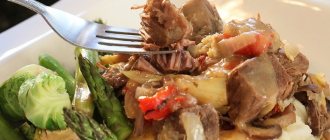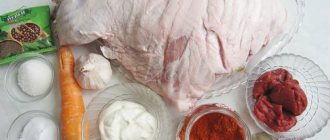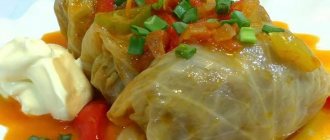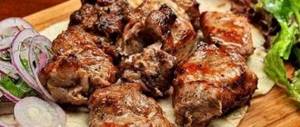Real Uzbek pilaf is crumbly rice of a pleasant golden color, large pieces of meat laid out around it and spicy spices that highlight the taste of the dish. It is not always possible to prepare it at home. Firstly, this requires a thick-walled cauldron, and secondly, it is recommended to cook it in the open air. Well, in general, the success of this dish of oriental cuisine largely depends on how correctly the zirvak is prepared. What it is, how and how much to cook it, we will tell you in our article. Let us dwell in more detail on spices for pilaf and other nuances on which the taste and aroma of pilaf directly depend.
What is zirvak?
In the East, it is believed that the most important part of pilaf is rice. It should remain crumbly in the finished dish, so you should choose only varieties with a low starch content. Yes, rice is really important. But the basis of real Uzbek pilaf is zirvak. A photo of this part of the dish is presented above. It takes much longer to cook than it takes to cook rice. So what is zirvak? How should it be cooked correctly to make the pilaf tasty?
Zirvak is a thick gravy, or rather a “pillow,” of vegetables and meat with spices, on which pre-soaked and washed rice is laid out. This part of the pilaf can be cooked in advance and then used to prepare the dish itself. In the original, zirvak is made with melted fat tail fat, in which first the meat, and then the onions and carrots are fried until golden brown. Then all the ingredients are poured with water and stewed with spices for a certain time. Rice is poured into the finished zirvak.
How to prepare zirvak for pilaf
The widespread distribution of pilaf throughout the eastern and further European territories has led to the fact that there are a huge number of species. The Persian tradition, for example, orders rice to be boiled separately, but in this case zirvak does not fulfill its traditional binding function. But we will talk about a classic example, which can be considered Uzbek pilaf, or rather Fergana pilaf, which most fully incorporates all the most common and popular eastern features. Accordingly, the recipe for pilaf and zarvak for him will be Uzbek.
What is zirvak
So, what is zirvak for pilaf? This is a pillow of vegetables and meat, on which rice is placed in a cauldron. A special charm of zirvak is that it is perfectly preserved in its finished form for a long time. And it can be used both for pilaf and other oriental dishes. For example, for lagman, shurpa and others requiring vegetables and meat.
Zirvak is a pilaf base made from carrots, onions, broth, spices and meat.
It is no coincidence that we put meat in last place. Contrary to popular belief that meat will not spoil pilaf, it is still not the main product here. And although meat is needed to add an additional note to the symphony of taste of the dish, its excess interrupts the aroma of spices and vegetables. In the historical homeland of pilaf, it is prepared without meat, and therefore when choosing, it is not the quantity that is important, but that it be of quality.
In the original, zirvak is cooked in melted fat tail fat, in which meat, carrots and onions are fried until nicely crisp, and then everything is poured with boiling water and stewed with spices. Next, rice is added. And now about preparing zirvak in detail. Pilaf should only be cooked in suitable containers. It could be:
- a cauldron is the best utensil, it distributes the heat from the fire and conserves heat perfectly;
- a saucepan with a thick bottom;
- as a last resort, it is recommended to use a cast iron casserole dish for pilaf.
The meat should be chosen young, not dark red. Uzbek pilaf is always lamb or beef, which can be flavored with fat tail fat to give it a lamb flavor. We definitely recommend adding cumin - its slightly stuffy aroma will add a subtle bouquet of Oriental flavor to the finished dish.
You can prepare real Uzbek pilaf with any part of lamb, but according to the technology, take the hind leg, cut out the tendons and cut the meat into small cubes of about 2 cm on each side. It’s no longer worth it, because lamb takes quite a long time to cook. Don't forget to take some seeds, it's better if they have cartilage.
It is recommended to use yellow carrots. It tastes no different from regular one, but is more aromatic, and a dish with it will be more “authentic.” The proportions of meat and vegetables in pilaf are approximately the same: as much meat as there are as many or even more carrots. The carrots are not scraped, but cut with a knife, and then cut into long bars. There is also a lot of onions. Depending on the tradition of the area, it is either fried until brown or left slightly toasted. In any case, onions impart color, aroma, and taste to rice, so don’t skimp on onions.
Proper pilaf does not tolerate trifles - even the water in it matters. You need to take bottled or filtered water. It is used for soaking rice, for zirvak, and if you need to add it to pilaf.
Cooking recommendations
Experienced chefs have several useful secrets for preparing this dish:
- Ideal pilaf can only be cooked in a cauldron. In such dishes, the heat spreads evenly and the heat lasts longer. At home, you can use a cast iron casserole dish or a regular pan with a thick bottom and walls.
- You can prepare real Uzbek pilaf from lamb or beef. Be sure to leave the fat tail fat in the pan, which will give the dish a specific note. As for a certain part of the meat, it is better to use the hind leg for pilaf, cutting out all the tendons from it.
- For zirvak, you need to take the same amount of carrots as meat. The vegetable should be cut into thin slices. Grated carrots are not suitable for zirvak.
- Water also affects the taste of the pilaf base. It is recommended to take filtered or bottled. Moreover, it should be used both for zirvak and for soaking rice.
Lamb pilaf - 16 delicious homemade recipes
Since pilaf itself is a national dish of countries adhering to the Muslim religion, it is prepared mainly from lamb meat. Because that is where it is produced and sold in large quantities.
The five most commonly used ingredients in lamb pilaf recipes are:
| Product | Calories kcal per 100g | Proteins g per 100g | Fats g per 100g | Carbohydrates g per 100g |
| Mutton | 169 | 18 | 11 | 0 |
| Carrot | 33 | 1.3 | 0.1 | 6.9 |
| Rice | 344 | 6.7 | 0.7 | 78.9 |
| Bulb onions | 41 | 1.4 | 0 | 10.4 |
| Zira | 112 | 12 | 5 | 32 |
You can use different types of lamb for pilaf: sirloin, bone-in, ribs. Of course, the most “delicious” will be the sirloin. The remaining products are as follows: rice, carrots, onions, fat tail fat (it can be replaced with any other fat or oil, be it butter or vegetable), salt and aromatic spices in the set (pepper, cumin, coriander, garlic, and so on).
In some countries, the preparation of lamb pilaf begins with calcining the fat and frying one onion in it, which is already hot. It should change color to completely brown, thereby imparting its aroma to the oil. What is fried in it is called “zirvak”, or, in other words, our basis for pilaf. The name may differ in different recipes. To do this, chopped onions, meat, carrots are fried and then spices are added. The entire frying should change color to golden brown and have an appetizing crust. Already at this moment you need to add salt.
Afterwards, pour hot water over everything and simmer for a while. Add rice and add water again so that it is two or three centimeters above the grain layer. When the water has boiled slightly, whole heads of garlic are pressed into the rice, which are simply thrown away after cooking. Different recipes for pilaf with lamb can be designed for different times - all this will be specially noted. In general, everything takes about two to three hours. And if you take into account the obligatory infusion of pilaf in heat, then even more.
Five of the lowest calorie lamb pilaf recipes:
| Name of the dish | Cooking time | Calories kcal per 100g | User rating |
| Lamb pilaf in a slow cooker | 1 hour 30 minutes | 110 | +54 |
| Azerbaijani pilaf | 1 hour 40 minutes | 133 | +22 |
| Tajik pilaf with lamb and cumin | 1 hour 30 minutes | 146 | 0 |
| Uzbek pilaf in a slow cooker | 2 hours | 149 | +144 |
| Pilaf with lamb and liver meat | 1 hour 20 minutes | 158 | +27 |
In addition to rice, pilaf can be prepared from: buckwheat, wheat, bulgur, pearl barley, couscous, barley, corn grits, millet. The dish is prepared in a saucepan, cauldron, slow cooker, double boiler, and sometimes in pots in the oven.
List of ingredients
When all the secrets are revealed, you can start preparing the correct zirvak for Uzbek pilaf. It is recommended to purchase products on the market, and immediately for a large company. The aroma during the cooking process is such that all the neighbors will definitely come running to the smell. The list of ingredients consists of the following products:
- tail fat (mutton fat) – 500 g;
- lamb – 1.5 kg;
- onion – 700 g;
- carrots – 1.5 kg;
- vegetable oil – 500 ml;
- garlic – 3 pcs.;
- salt;
- spices.
Contrary to popular belief, meat in pilaf is not the main product. It definitely won’t ruin the dish. There shouldn't be too much of it. Excess meat interrupts the taste of spices and vegetables. The resulting volume of zirvak will be enough to prepare pilaf from 1 kg of rice.
How to choose the right spices?
It is impossible to give a complete description of what zirvak is without mentioning the spices that make pilaf so aromatic and tasty. The most important spice in this dish is considered to be cumin. The seeds of this plant are used in cooking. To check whether the purchased cumin is counterfeit, you need to rub the grains between your fingers and feel the aroma.
In addition to cumin, other spices are also added to zirvak (arranged in order of importance after cumin):
- barberry - dried berries of the plant are added to pilaf to neutralize fat and add a piquant sour note;
- garlic – enhances the taste and aroma of the finished dish;
- hot pepper – gives the dish a fiery taste;
- saffron – gives a light, pleasant aroma and golden color.
Due to the high cost of saffron, turmeric is sometimes used when preparing pilaf at home. For 1 kg of rice and meat, it is usually enough to add half a teaspoon.
Homemade pilaf sauce
It will take a little time to prepare, but the result will exceed expectations!
Includes:
- Bulbs - 2 pcs.
- Fresh tomatoes - 4 pcs.
- Salad oil - 3 tablespoons. l.
- Garlic - 3-4 cloves.
- Cilantro or parsley - 1 bunch.
- Salt, pepper - to taste.
- Sugar - 1 tsp.
As you know, the main ingredient in most sauces is tomatoes. Fresh or pickled. The difference is small. I offer a recipe on how to make pilaf sauce from fresh vegetables at home. Onions need to be peeled and finely chopped. It is better to scald the tomatoes to make it easier to remove the peel. The tomatoes also need to be chopped. Pass the peeled garlic through a garlic press or crush each clove with a knife and chop finely. Heat the oil in a frying pan and sauté the onion over moderate heat for about 5 minutes. Then add the garlic and, stirring, simmer for another 5 minutes. Add salt, sugar and pepper. Throw in the tomatoes. Stir and, reducing the flame to low, simmer for 5 minutes. Remove the finished sauce from the heat, add chopped cilantro or parsley leaves, mix and let cool under the lid. Mix the cooled mixture in a blender and place in a salad bowl or gravy boat. If you want to get a hot sauce, then when mixing in a blender, add 2-3 more crushed cloves of garlic and ground red pepper. This sauce can be easily prepared from canned tomatoes, but during preparation you need to take into account the salt content in the tomatoes.
Homemade preparations for the winter, such as pickled tomatoes and cucumbers, also go well with pilaf. Slice cucumbers and tomatoes into a cup of brine and serve as gravy.
Step by step recipe
You can learn how to prepare zirvak from the following detailed instructions:
- Heat a cauldron over high heat.
- Cut the fat tail fat into small pieces. Place it in a heated cauldron to render the fat. Reduce the heat to medium.
- Meanwhile, cut the lamb into medium-sized pieces.
- Chop the onion into half rings and the peeled carrots into strips.
- Using a slotted spoon, remove any cracklings from the fat that has melted in the cauldron. Pour vegetable oil into it and heat it well.
- Place half an onion in a cauldron and soak it in the fat until it turns brown, then remove with a slotted spoon. The onion will remove the unpleasant aroma from the oil.
- Place the meat in a cauldron and fry it well on all sides. As soon as the lamb is browned, add onion cut into half rings into the oil.
- After 5 minutes, add carrots. Add salt, pepper, mix.
- Add enough water to cover the entire contents of the cauldron.
- Add cumin (1-2 tsp). Cut off the top or bottom of each head of garlic and place it directly in the peel in a zirvak.
- After 30 minutes, remove the garlic from the cauldron, and instead add barberries and a pod of hot pepper (optional). Simmer the zirvak until cooked for another 20 minutes. After this you can add rice.
Recipes for pilaf with cumin
With pork and barberry
To prepare a delicious dish you will need:
- 1 tablespoon of cumin seeds;
- 5 cloves of garlic;
- 3 tablespoons barberry;
- 3 carrots;
- 3 onions;
- 500 g coarse grain rice;
- 1 kg of pork or lamb;
- 2 tablespoons salt;
- Sunflower oil.
The meat should be cut into pieces and fried in very hot oil in a cauldron. The carrots are peeled and chopped; the same goes with the onions.
The rice is pre-washed three times and then poured with boiling water. Add all the spices to the cauldron with meat, after 5 minutes add rice and carrots with onions. Garlic is placed in a cauldron with whole cloves, without passing it through a press. It is important to add hot water to the cauldron; it should cover the rice and cape. The pilaf is cooked under the lid over low heat; the dish should simmer for about half an hour.
Be sure to let the pilaf brew and absorb all the aromas and flavor notes of the spices. The pilaf should stand under the closed lid for about half an hour.
With chicken and coriander
To prepare the dish you need:
- 500 gr. chicken fillet;
- 4 onions;
- 4 cloves of garlic;
- 500 gr. rice;
- 1 tablespoon ground coriander;
- 1 tablespoon ground cumin;
- 1 teaspoon ground chili pepper;
- 500 gr. carrots;
- 150 ml. vegetable oil;
- salt;
- 1 teaspoon paprika.
The chicken is cut into small cubes, and the vegetables are peeled and chopped. The rice is pre-washed. Sauté vegetables and chicken in a frying pan over high heat. Fry until the meat is done.
Take a wog or deep cauldron and put meat and vegetables into it. Pour in rice and add whole peeled cloves of garlic.
The rice in the pilaf is not stirred after filling, so that later it does not turn out to be porridge with meat.
Reduce the heat under the wog or cauldron and cook the pilaf until done, about 40 minutes. After cooking, the pilaf should be stirred and left covered for half an hour to saturate the taste.
How long does it take to cook zirvak for pilaf?
The preparation time for the aromatic gravy of meat, vegetables and spices is 45-50 minutes. But you need to consider what kind of meat is used in the zirvak recipe for pilaf. For example, it will take much less time to cook gravy from chicken than from lamb. In this case, 30 minutes will be enough.
The readiness of zirvak can be determined by taste and visually. A film of fat forms on the surface; there should be no foam. The correct zirvak should be transparent. If the broth turns out cloudy, the rice will absorb all the moisture and become mushy. And this is unacceptable in real pilaf.
The most accurate recipe for real Uzbek pilaf: secrets of the best chefs!
These secrets made me a master in preparing pilaf. Now my husband has forgotten about dumplings and cabbage rolls: he only asks for pilaf, he doesn’t even want to look at pizza!
Do you know how tasty real Uzbek pilaf is? There are legends about this dish. However, what distinguishes amazing pilaf from porridge that imitates it are several small nuances. Get to know the secrets of real pilaf from the best oriental chefs!
1. Pilaf cannot be cooked in any container. Thick cast iron pans are best suited for it. Deep, thick frying pans and cast iron pots are good. In all cases, the lid must fit tightly to the container.
2. Carrots for pilaf must be cut into long strips. Those who grate it are making an irreparable mistake. In fact, the longer the straw, the tastier the pilaf will be!
3. Salt and spices must be added halfway through the preparation of the carrot, meat and onion dressing.
4. Even if you really want to look into the pan and see what's going on there, don't do it until the recipe allows it.
5. Under no circumstances should you mix meat and rice in a pan while they are still cooking. This is done. Ideally, the pan with the finished pilaf should be wrapped in a blanket and allowed to stand for another half hour to an hour - this will make it even tastier!
And now a step-by-step recipe for real Uzbek pilaf:
- Pour vegetable oil into a frying pan and heat it.
- Place onion cut into half rings and fry until golden brown.
- Cut the beef into cubes (the cubes should be large) and add the onion. Add coarsely chopped (as described above) carrots.
- Salt it all and fry it properly.
- Now fill this with boiled water so that the carrots are covered by 3-4 cm.
- Now reduce the heat and simmer this broth (in Uzbekistan it is called zirvak) over low heat. Usually, the longer it is cooked, the more tasty and aromatic the pilaf will be.
- Rice is the most important thing in pilaf. For pilaf you should buy the hardest varieties. But if there are no such varieties in your region, take long, not round rice. It is not at all necessary to soak it, especially if you like your pilaf crumbly. Sort the rice and rinse.
- Before pouring rice into the cauldron and starting cooking, ask whether the zirvak is well salted. It should be slightly saltier than, for example, soup. Simply put, it should be a little salty. This is necessary because the rice will absorb some of the salt. If the zirvak is salted in moderation, the pilaf will turn out fresh. This is extremely important!
- Now you should start pouring the rice evenly, carefully adding boiled water in such an amount that the rice is covered on top by 2 cm. Add fire and wait until the rice absorbs the water.
- After this, use a wooden spoon to make holes in the rice all the way to the bottom (it is best to do this with the handle of a wooden spoon or a special stick). There should be 5–7 such holes. This is necessary so that the water is absorbed as quickly as possible and the zirvak does not burn.
- We carefully look inside the holes, piercing them again from time to time. If the liquid in the wells has a cloudy appearance, then there is still water.
- And when it starts to shine, it means the liquid has been absorbed and only oil remains. When this happens, the heat should be reduced to a minimum, the rice should be collected, giving it a mound shape, and sprinkled with cumin on top and cover with a lid.
- Now we wait 20 minutes. Alternatively, you can let the pilaf stand for another quarter of an hour on very low heat, then turn it off, stir well and let it stand again for about 10 minutes.
That's all: you've just prepared pilaf in Uzbek style! Eat and enjoy!
By the way, some people add barberry, garlic, quince or chickpeas to pilaf. In spring, it is often filled with minced meat wrapped in fresh grape leaves. This makes the pilaf even tastier and gives it a wonderful sourness!
Bon appetit!











